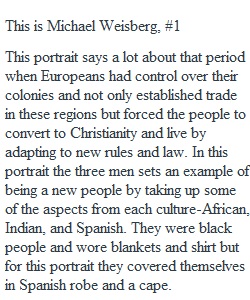


Q A VISUAL RECORD OF THE PAST: "The Mulatto Gentlemen of Esmeraldas", Ecuador This group portrait, painted in 1599 by Andrés Sánchez Gallque, is the oldest surviving dated painting from colonial South America. The three nearly life-size figures are identified by name and age, all with the Spanish honorific title of don: Don Francisco de Arobe, age 56, in the middle, flanked by his son, Don Pedro, age 22, and another young man, Don Domingo, age 18. Don Domingo was the leader of an independent community of free black Africans and Indigenous peoples in the province of Esmeraldas on the north coast of Ecuador. In 1599, Don Francisco and his community visited the colonial capital of Quito to formally accept Spanish authority and Christianity. Spanish authorities commissioned the portrait and sent it to Spain as a memento of the event. __________________________ DISCUSSION Consider the painting "The Mulatto Gentlemen of Esmeraldas". How does the portrait show Don Francisco and his young companions as new people in a cultural sense - part African, part Indian, part Spanish Christian, and now American (in the broadest sense of the term - belonging to the Americas)? What feelings and thoughts does this portrait trigger in you? You are expected to post a minimum of 3 times this week - this includes: 1 response (250-400 words) to the questions I posed; 2 or more responses to others in your group (minimum 50 words). Be sure to identify yourself in your post and state what post number it is by adding a subject line (for example: this is Philippe Zacair, # 2). That will help me to keep track of your posts and make sure you get credit. Check your Discussion Forum Rubric here Actions MAIN POST DUE: THURSDAY, FEBRUARY 17 @ 11:59pm REPLIES TO PEERS DUE: SUNDAY, FEBRUARY 20 @ 11:59pm
View Related Questions